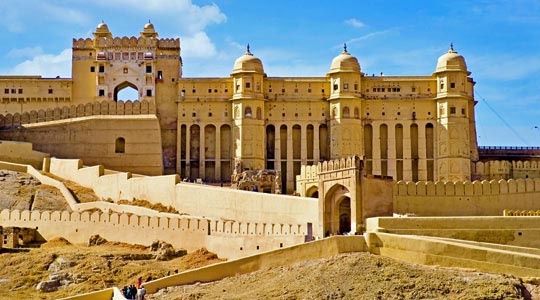Amer Fort / Amber Fort, Jaipur

Information on Amer Fort / Amber Fort (Jaipur, Rajasthan) - History & Architecture
Amber Fort / Amer Fort, which is also termed as Amer Fort/Palace is one of the most well-known forts of Jaipur. The fort was established in the year 1592 by Raja Man Singh. It is a major tourist attraction in Jaipur area. Basically, Amber Fort is famous for its creative appearance, having large walls, series of entrances and cobbled pathways. It contains various castles, gardens and lakes among others. Similar to other historic sites of India, Amber Fort concentrates on conservation. Situated from about 11 kilometre from Jaipur, Amber Fort represent rich composite of royal fortresses and other antique constructions.
Amer Fort / Amber Fort, Jaipur Architecture
Amber Fort is influenced by both Hindu as well as Muslim architecture. For example, certain buildings of the fort project Muslim architecture such as 'Diwan-i-Aam' and the 'Sheesh Mahal' and some portion represent Hindu architecture such as 'Shila Devi' sanctuary and 'Ganesh Pol'. The fort has four diverse portions and every portion have discrete entrance. The central entrance of the fort is through 'Suraj Pol', also termed as 'Sun Gate' which led to the main yard. It was the place where Territorial Army hold victory parades on their return from battles.
Basically, Amber Fort has four courtyards. The first courtyard of Amber Fort is 'Jaleb Chawk'. At the right side of Jaleb Chawk, there is 'Sila Devi' sanctuary, where Rajput maharajas used to worship. The second courtyard of Amber Fort is renowned for its 'Diwan-i-Aam', 'Seesh Mahal' and 'Sukh Mahal'. The third courtyard of Amber Fort is regarded as private accommodations of king. This courtyard is entered through Ganesh Pol. The key attraction of this place is 'Magic Flower' and a painting imprinted marble. The fourth courtyard of Amber Fort is where royal family, comprising queens resided. The key attraction of this courtyard is Jas Mandir, having flowery glass tiles and alabaster works.
Amer Fort / Amber Fort, Jaipur History
Amber was traditionally ruled partially by Minas and Rajputs until 11th century AD,. Afterwards, Kachhawas conquered this region and remained as rulers until the incorporation of Princely States. Amber reached its pinnacle of growth during medieval age when Beharimal took over the sovereignty. The rule of Beharimal highlighted the introduction of new era in Amber. On that time Amber enjoyed constant stability, harmony and prosperity, with the coalition from Mughal king. The period of late 16th century and early 18th century was considered as golden period of Amber, with the rule of Man Singh and Raja Jain Singh. It was during this time, most of the construction was elaborated and among the magnificent construction, Diwan-i-Khas is the main centre of the building which is elaborately decorated and painted. They have made significant contribution to the architecture in Amber, which was mainly influenced by Mughal creation.
Amer Fort / Amber Fort, Jaipur Tourism Importance
Tourism in Amber started through British era. On that time, various European travellers visited Amber. Amber Fort and nearby areas were captivated by several European travellers. Presently, Amber Fort is regarded as a vital tourist destination. It contributes about one-third of Jaipur's total income from tourism. The fortifications of Amber are also included in the list of World Heritage Sites. It's wonderful architecture and scenery attracts large number of local as well as global travellers. In Amber, tourism has increased since colonial period and today, Amber Fort is regarded as one of the most visited sites in Jaipur. In accordance with the study of 'Department of Archaeology and Museums', about 5000 travellers visit Amber Fort in a day throughout the peak holiday season.
While here in Jaipur, don't miss the opportunity to witness the marvel, which has witness the glorious history of the Rajputs, downfall of many great rajas and maharajas and more of all it stands even today with the same pride tempting visitors with its opulent architecture.
- Andaman Nicobar Monuments
- Andhra Pradesh Monuments
- Assam Monuments
- Bihar Monuments
- Chhattisgarh Monuments
- New Delhi Monuments
- Goa Monuments
- Gujarat Monuments
- Haryana Monuments
- Himachal Pradesh Monuments
- Jammu and Kashmir Monuments
- Karnataka Monuments
- Kerala Monuments
- Madhya Pradesh Monuments
- Maharashtra Monuments
- Odisha Monuments
- Punjab Monuments
- Rajasthan Monuments
- Tamil Nadu Monuments
- Telangana Monuments
- Uttar Pradesh Monuments
- West Bengal Monuments